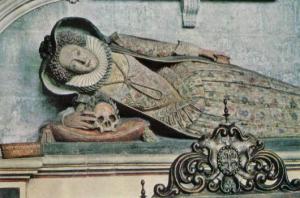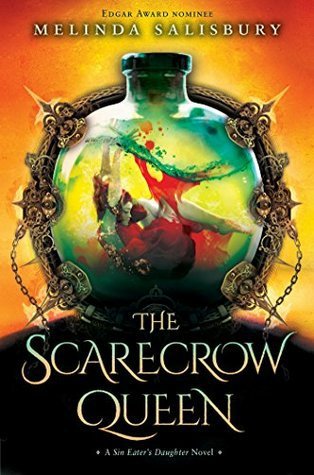It wouldn’t be a true Auckland TheoRel student showcase without at least one piece of work on Delilah, our favourite biblical femme fatale. This year, we have not one but two essays to share, and each one offers us something a little bit different than our usual focus on Delilah’s explicit afterlives in popular culture. Starting us off, Katherine Sherliker considers a more implicit portrayal of a Delilah-like character in the hit TV series Criminal Minds. Katherine hails from Northampton, UK, and has been living in Auckland since 2008. She has just finished her first year of a Bachelor of Arts, majoring in linguistics, with a minor in education. She hopes to do a Master of Speech Language Therapy Practice after completing her BA. Katherine took our Bible and Popular Culture course because she thought it looked interesting, and was particularly drawn to the promise made in the syllabus that we’d be studying Harry Styles. It appears to have lived up to her expectations, as she describes it as her favourite course so far (and yes, Harry was the subject of one of our lectures).
So, if you are as big a Delilah fan as I am, you will enjoy this essay very much indeed.
 Kat Adams in Criminal Minds (CBS)
Kat Adams in Criminal Minds (CBS)
A Game of Cat and Mouse
Criminal Minds’ Cat Adams as an Implicit Portrayal of Delilah
Katherine Sherliker
Deceptive, vindictive, seductive and dangerous. This is how the biblical character Delilah is portrayed in popular culture, but it has no basis in the original text of Judges 16. This negative image of Delilah as a femme fatale, the fatal woman, is preserved in cultural retellings of the Samson and Delilah text, both explicitly and implicitly. The story of Cat Adams, a serial killer and hit-woman, from Jeff Davis’ crime drama television series Criminal Minds, is an implicit portrayal of Delilah from the Samson and Delilah story. Manipulation, selfishness and betrayal are common themes in both Cat’s and Delilah’s narratives, but can these characters be seen in more positive lights? This essay will explore how an implicit retelling of Judges 16 allows the Delilah character to be rethought in different ways that subvert the traditional tropes of the femme fatale.
In Criminal Minds, Cat is depicted as a manipulative femme fatale character, much like Delilah is in explicit retellings of the Samson and Delilah story. The femme fatale figure contains four common traits: she is seductive, she has power over men, she is deceptive, she is mysterious and therefore, she is dangerous (Clanton 2014, 1155). Hit-woman Cat specialises in seduction, and she acquires all information that she possibly can about the men she is hired to kill. In order for her victims to not foresee their death, Cat puts them in a compromised position by learning all there is to know about their physical, emotional and psychological state (“Entropy,” Season 11 Ep. 11, 2016). Extremely patient, she spends years studying her targets, so that her exploitation and manipulation has maximum effect, intending for them to commit suicide: “When I do it really well they pull the trigger themselves” (ibid.)
 Cat Adams and Spencer Reid (CBS)
Cat Adams and Spencer Reid (CBS)
Cat’s modus operandi is seen as outrageous and shocking, but it is also comparable to Delilah deceiving Samson, especially in explicit retellings. Despite not being as patient and insidious as Cat, in the Book of Judges (Judges 16:6-18) Delilah repeatedly asks Samson to tell her the source of his strength, eventually manipulating him by saying, “how can you say, ‘I love you,’ when your heart is not with me?” (Judges 16:15). This clever exploitation of Samson’s emotions is the statement that makes interpreters see Delilah as deceptive, as it appears that she had intent to instill guilt into him (Clanton 2009, 67-8). Smith argues that Delilah knew that she must get into Samson’s mind in order to overpower him physically (1997, 51). The characterisation of Delilah as a femme fatale stems from this perception that she knew of Samson’s lust for her, which is why she uses seduction and her sexuality to trap and weaken him (52).
 Cat and Spencer (CBS)
Cat and Spencer (CBS)
Much like the cultural portrayals of Delilah, Cat also uses her sexuality to get what she desires. Cat, despite being heterosexual, uses the art of seduction to deceive fellow hit-woman Lindsey Vaughn by pretending that she is in love with her – this convinces Lindsey to frame Dr. Spencer Reid, who is Cat’s main rival, in order to fulfil her partner’s wishes (“Green Light,” Season 12 Ep. 21, 2017). However, Cat also uses her high intelligence and quick wit to eliminate her enemies. This is a stark contrast to the Delilah character, who is commonly understood and portrayed to have used only her sexuality to undermine Samson. Cat is a genius at solving problems and planning, for example, she assembled a group of criminals with their sole purpose being to punish Dr. Reid, all while she was incarcerated in Mount Pleasant Women’s Correctional Facility (“Red Light,” Season 12 Ep. 22, 2017). She also terminated an undercover operation almost immediately by identifying all of the undercover agents in the restaurant, knowing that it was a trap because of her clever researching and planning beforehand (“Entropy” 2016). Cool and confident, the fatal woman says, “I didn’t walk into your trap, you walked into mine” (ibid.). The use of intelligence as the ‘dangerous’ aspect of the femme fatale is a refreshing way to rethink the character, given Delilah’s beauty and seductiveness, rather than her intellect, are consistently emphasised as her fatal qualities.
 Maeve and Spencer …
Maeve and Spencer …
Another prevalent depiction of the Delilah character is one that is selfish and jealous. A common theme in Delilah’s afterlives is that she is jealous of another female in Samson’s life. In the original story of Samson, there is an allusion to Delilah being the exact opposite of the perfect woman (Smith 1997, 52). Judges 13-16 reinforces the virgin/whore binary by identifying the “good” woman and the “bad” woman – the good woman being maternal, plain and chaste, and the bad woman being openly sexual and a harlot (Exum 1996, 186). In the biblical text, an example of a good woman is Samson’s mother in Judges 13, as she fulfills the two main gender roles – being a mother and a wife, while Delilah is the bad woman, as she is provocative and unattached (ibid.). In Delilah’s afterlives, there is often a woman who is a foil to her, and this also appears with Cat in Criminal Minds. Maeve Donovan was Dr. Reid’s partner, and she was plain and modest in appearance, and demure and meek in her personality – a complete contrast to Cat (“The Lesson,” Season 8 Ep. 10, 2012). Cat, being in love with Dr. Reid, was excessively jealous of Maeve, and this sparked her rampage of manipulation and deceit against him (“Red Light” 2017). This obsessive love and jealousy compels her to want the destruction of the man she desires – “if I can’t have him, no one can” – a classic femme fatale quality.
 …compared to Cat and Spencer
…compared to Cat and Spencer
The betrayal of the men that she is involved with further reinforces the view that the Delilah character is selfish and jealous. It is obvious that Delilah betrays Samson’s trust by submitting him to the Philistines, which paints her as untrustworthy and sinful (Gervin 2017). The biblical text declares that Samson is “in love” with Delilah (Judges 16:4), which makes her betrayal much more malicious than if he did not care for her. Delilah’s actions also disrupt gender boundaries as she emasculates the man – a corrupt act, and a main trait of the femme fatale (ibid.). This act of deception is why Delilah has become the epitome of the femme fatale, as her unconcealed sexuality and seduction is what was dangerous and ultimately fatal to Samson (Exum 1996, 176). Again, Cat is similar to this, as she is known to betray some of her clients by killing them instead, especially men who ask her to kill their wives (“Entropy” 2016). This brings a grim meaning to femme fatale – a literal fatal woman.
 Cat (CBS)
Cat (CBS)
With the femme fatale character’s betrayal and manipulation of men, a question needs to be asked – why do they do this? Both the biblical Delilah and her afterlives may have legitimate reasons for their actions, allowing them to be seen in a more positive light. For example, it is made obvious in Judges 16 that Samson has great physical strength. As a woman, Delilah is less physically powerful than Samson, especially with his extreme strength. Delilah may have been fearful of Samson, and finding the source of his strength would be the only way to overcome him (Smith 1997, 55). Cat is also physically vulnerable. As a contract killer, she has to get physically close and personal with her targets, which could end badly as many of them were powerful men (“Entropy” 2016). Also, in terms of wealth, the Delilah character may have been dependent on others for money. In Judges 16:5, the five Philistine leaders offer Delilah “eleven hundred pieces of silver” each to subdue Samson. As the biblical text does not mention any of Delilah’s relatives or any ways she was earning money, it can be interpreted that she was alone and perhaps financially unstable. The money that the Philistines offered her may have been her only way to gain economic independence (Smith 1997, 55). Again, Cat is somewhat similar to this, as being a hit-woman is her job, and if she mishandled a situation her career, and even her life, could be over.
 Cat and Spencer (CBS)
Cat and Spencer (CBS)
Most importantly, Delilah can be seen as socially and emotionally vulnerable – though this is rarely considered in her afterlives. Delilah may feel like an outcast, as it is often suggested that she is a foreign woman, possibly a Philistine among Hebrews (Exum 1996, 181). She also may be fearful of repercussions if she does not fulfill the Philistine lord’s wishes, as it is feasible that she has no political power to negotiate. Despite some of her unlikable femme fatale qualities, Cat can also be seen as emotionally vulnerable. Her backstory is tragic, as she was abused as a child by her father, who was jailed for killing her mother (“Entropy” 2016). She was then mistreated by her foster father (ibid.). After this, Cat spent the rest of her life trying to find her father who was eventually released from prison, all while taking her anger out on men who reminded her of him (ibid.). The emotional turmoil Cat experienced as a youth could have changed her into the manipulative and vindictive femme fatale character that she was in her adult life. This is an interesting way to look at the femme fatale character – these women are often vulnerable and act to protect themselves. Viewing the femme fatale as sensitive and possibly defenseless allows the original Delilah character to be seen the same way.
Cultural retellings of the Samson and Delilah story usually lack positive views of Delilah, instead depicting her as destructive and scandalous. It is important to realise that this has no basis in the original text, and is instead a result of these traits being preserved in cultural retellings. Criminal Minds’ Cat Adams is an implicit portrayal of Delilah, as she is remarkably comparable to Delilah’s afterlives and the overall femme fatale figure. These indirect retellings of the story and recreations of the character allow Delilah to be rethought in a new light. Portrayals of Delilah such as this one allow us to rethink why she may have betrayed Samson. Instead of automatically blaming it on her being malicious, we can speculate about her economic, social and physical vulnerability, and why this drove her to her actions. The limited description of Delilah in Judges 16 leaves a great deal to the imagination, so why not reimagine her in a positive light for a change?
 Cheers, Cat!
Cheers, Cat!
References
References to the Bible are taken from the New Revised Standard Version.
Clanton, Dan W. “Trollops and Temptresses.” In Daring, Disreputable, and Devout: Interpreting the Bible’s Women in the Arts and Music, 65-77. New York: T&T Clark, 2009.
“Entropy.” Criminal Minds. Created by Jeff Davis. United States: CBS, January 13, 2016.
Exum, C. J., “Why, why, why Delilah?” In Plotted, Shot, and Painted: Cultural Representations of Biblical Women, 175-237. Sheffield, England: Sheffield Academic Press Ltd, 1996.
Clanton, Dan W. “Femme Fatale: III Film.” In Encyclopedia of the Bible and Its Reception, 1155-7. Berlin: De Gruyter, 2014.
Gervin, L. “Women as Deceivers in the Hebrew Bible.” Women in Judaism: A Multidisciplinary Journal 13, no. 2 (2017): 1-11.
“Green Light.” Criminal Minds. Created by Jeff Davis. United States: CBS, May 3, 2017.
“Red Light.” Criminal Minds. Created by Jeff Davis. United States: CBS, May 10, 2017.
Smith, Carol. “Samson and Delilah: A Parable of Power?” Journal for the Study of the Old Testament 22, no. 76 (1997): 45-57.
“The Lesson.” Criminal Minds. Created by Jeff Davis. United States: CBS, December 5, 2012.
Advertisements Share this:





